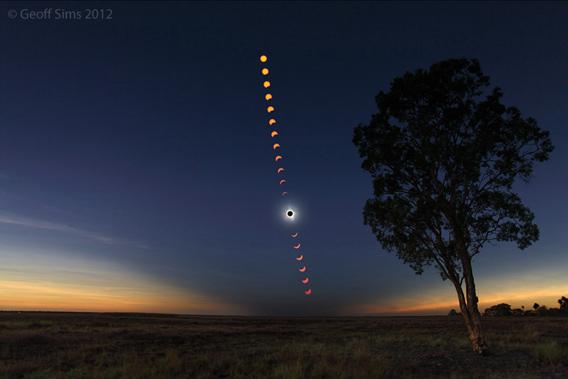Last week, a narrow path along the Southern Hemisphere was treated to a total solar eclipse, one of the most beautiful of all natural events. When the Moon covers the Sun, the bright glare of the solar disk goes away, revealing the beautiful, ethereal solar corona. This is the Sun’s atmosphere, if you will, which extends outwards for hundreds of thousands, even millions of kilometers.
The Moon orbits the Earth, and the Earth spins, so the shadow of the Moon traces a long, gently curving path across the Earth’s surface. It passed only briefly over land, near Cairns, Australia. Still, some amazing photographs and videos were taken. Universe Today has quite a few, but in particular I want to show you a photo and a couple of videos.
Geoff Sims is a photographer who was at the eclipse and took an amazing series of photos. He used them to create a time-lapse animation of the event, and it’s simply spectacular:
While it’s hard to get a sense of the eclipse itself in that video, what really blew me away was the dark streak that moved across the sky itself from left to right. Watch the video again: It’s a long, triangular blackness wider near the top of the frame and narrowing toward the bottom.
See it? That’s the actual shadow of the Moon! It’s actually ellipse-shaped, but due to perspective it appears to narrow like a triangle in the distance, similar to the way railroad tracks look like they converge toward the horizon. The Moon is moving from the upper left to the lower right, and its shadow is sweeping across the Earth at a speed of about 1 kilometer per second—the same as a rifle bullet! You’re seeing it here darkening the high clouds that were in the sky at the time. Incredible.
Geoff also combined a series of photographs to show the sequence of events in one stunning photo:
The Sun was rising during the eclipse, so the sequence starts at the bottom and moves up. He took a photo every four minutes or so to create this amazing shot, and again you can see the actual shadow of the Moon on the sky.

Image credit: Geoff Sims, used by permission.
Finally, here’s a video taken by YouTube user solareclipse eclipsevidgale, showing a real-time view of the event:
In this video you can see the famous “diamond ring” effect, where just before the Moon completely covers the solar disk you can still see a ring of Sun around the Moon’s dark disk, and the glare from the last bits of the unblocked Sun create what truly does look like a diamond ring. During totality, the corona is easily visible, and you can see flashes of red and pink along the edge of the Sun. That’s real: The Sun is not solid, but is actually a very hot gas called a plasma. The surface of the Sun is layered, and the topmost layer is called the chromosphere, which glows red. However, the next layer down, called the photosphere, is hugely brighter, and usually totally overwhelms the ruddy light coming from the chromosphere.
During an eclipse, though, the photosphere is blocked, so some of the redder chromosphere light can be seen. In the video it’s a bit overexposed so it’s still not easy to make out, but flashes of it appear along the Moon’s edge.
If you’ve never seen a total solar eclipse, perhaps you can take some small comfort in this: I haven’t either. It’s ridiculous; I’ve been an astronomer my whole life, and this is one of the most awe-inspiring astronomical events there is. But here I am.
Still, I’ll get my chance: In 2017, the path of the Moon’s shadow will pass not 500 kilometers north of my house, going right over Casper, Wyoming. I don’t think it’ll be too hard to talk myself into that particular four-hour drive.